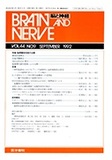Japanese
English
- 有料閲覧
- Abstract 文献概要
- 1ページ目 Look Inside
ある種の水頭症で頭蓋内圧脈波(ICPPW)の脈圧(PP)が増大していることが明らかとされている。この変化は頭蓋脊髄腔のcomplianceの低下によると考えられるが,PPが増大しこれが脳室拡大のdriving forceとして作用している可能性も否定できない。この点を明らかとするために犬を用いて以下の実験を行った。4群においてカオリン注入により水頭症を作製した。脳室拡大の程度はMRIにより評価した。A群:コントロール群,B群:片側頭蓋骨を切除した群,C群:片側頭蓋骨,硬膜を切除した群,D群:片側頭蓋骨,硬膜,側頭筋を切除した群。各群両側側脳室においてICP, PP, PVR(圧—容積反応,頭蓋腔のcomplianceを示す)を測定した。D群のみ開頭側が健側に比しより著明な,他は左右対称の脳室拡大を示した。ICPは各群間で差を認めなかったが,PP, PVRはAからD群に向かい低下した。D群を含め各群とも,両側側脳室間でPP, PVRの差は認めなかった。以上より本モデルにおいては,PPは脳室拡大のdriving forceではなく頭蓋腔のcomplianceを反映している可能性が示唆された。
Purpose : Much has been written about the rela-tionship between the pulse pressure (PP) of the intracranial pressure pulse wave (ICPPW) and ventricular dilatation. Some data suggest that high PP is the cause of ventricular dilatation, and other authors have reported that high amplitude of PP results from decreased intracranial compliance. In order to clarify these points, the amplitude of PP and Pressure-Volume Response (PVR : an indica-tor of intracranial compliance) were measured in bilateral ventricles using Howchwald's hydroce-phalic model (right-left difference in ventricle size is clear, due to hemicraniectomy).
Methods : Hydrocephalus was developed by means of intracisternal injection of a Kaolin powder solution using dogs. The mean ICP, amplitude of the PP, PVR and ventricular size (studied by MR image) were evaluated under pathological condi-tions induced by the following procedures. Group A : control. Kolin induced hydrocephalus without craniectomy. Group B : Kaolin induced hydroce-phalus with right side craniectomy. Group C : Kao-lin induced hydrocephalus with right side craniectomy and dural resection. Group D: Kaolininduced hydrocephalus with right side craniectomy, dural resection and temporal muscle resection.
Results : Using MR imaging, the same degree of symmetrical ventricle dilatation were identified in all groups except Group D. Group D alone demon-strated the difference of ventricular size (craniectomy side>non craniectomy side) . There was no appreciable difference in mean ICP between each group. However the amplitude of PP and the PVR decreased stepwise from Group A to Group D. The difference of the amplitude of the PP and PVR between the right and left ventricles in each group was not significant. Even in the larger ventricle side(right) of Group D, the amplitude of PP was same as that of the left ventricle, and much smaller than that of other groups.
Conclusion : The results of our research suggest that : 1) There was no relation between the ventricular dilatation and the amplitude of PP. This means that the increased amplitude of PP was not the cause of the ventricular dilatation in this model. 2) These evidences suggest that a high degree of correlation exists between the amplitude of PP and the PVR. This means that PP can be a good parame-ter of the intracranial compliance in this model.

Copyright © 1992, Igaku-Shoin Ltd. All rights reserved.


